The AMD A8-7670K APU Review: Aiming for Rocket League
by Ian Cutress on November 18, 2015 8:00 AM ESTGaming Benchmarks: Low End
To satisfy our curiosity regarding low-power gaming, as well as dual graphics arrangements, we ran our regular suite through each processor. On this page are our integrated graphics results, along with a cheaper graphics solution in the R7 240 DDR3 and, in the case of AMD, both of these together in dual graphics mode.
Alien: Isolation
If first-person survival mixed with horror is your sort of thing, then Alien: Isolation, based off of the Alien franchise, should be an interesting title. Developed by Creative Assembly and released in October 2014, Alien: Isolation has won numerous awards, ranging from Game Of The Year to several top 10s/25s and Best Horror titles, ratcheting up over a million sales by February 2015. Alien: Isolation uses a custom-built engine that includes dynamic sound effects and should be fully multicore enabled.
For low-end graphics, we test at 720p with Ultra settings, whereas for mid- and high-range graphics, we bump this up to 1080p, taking the average frame rate as our marker with a scripted version of the built-in benchmark.

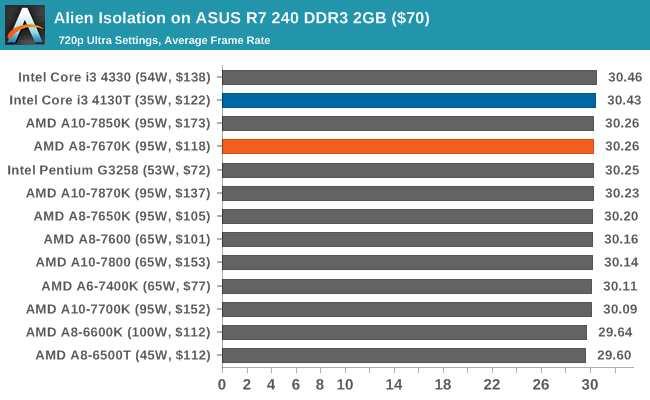
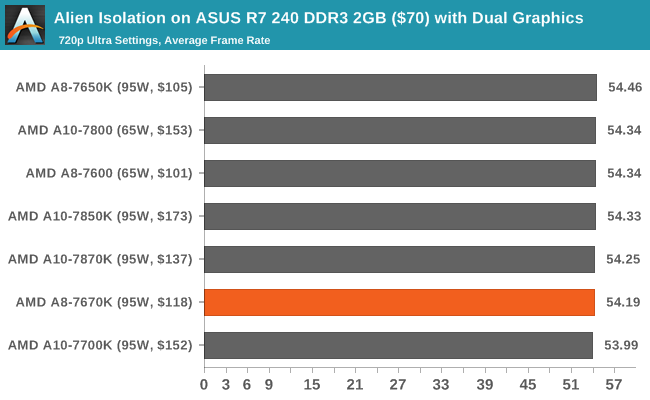
Total War: Attila
The Total War franchise moves on to Attila, another Creative Assembly development, and is a stand-alone strategy title set in 395AD where the main story line lets the gamer take control of the leader of the Huns in order to conquer parts of the world. Graphically, the game can render hundreds/thousands of units on-screen at once, all with their individual actions, and can put some of the big cards to task.
For low-end graphics, we test at 720p with performance settings, recording the average frame rate. With mid- and high-range graphics, we test at 1080p with the quality setting. In both circumstances, unlimited video memory is enabled, and the in-game scripted benchmark is used.
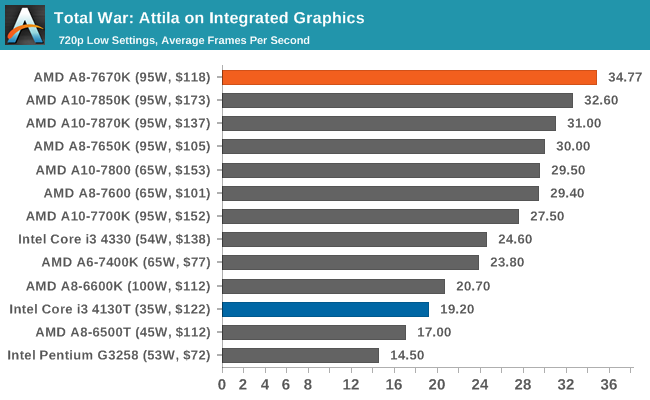

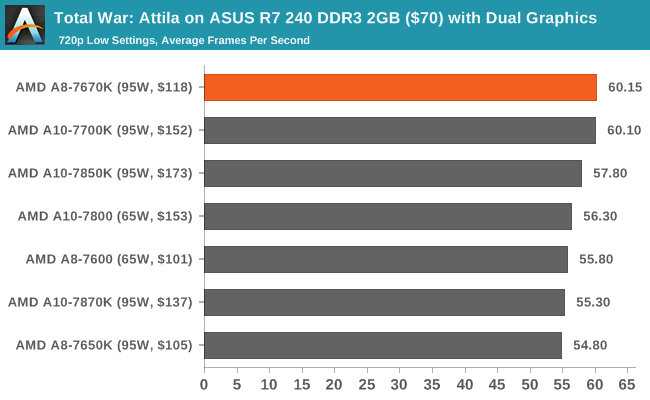
Grand Theft Auto V
The highly anticipated iteration of the Grand Theft Auto franchise finally hit the shelves on April 14, 2015, with both AMD and NVIDIA in tow to help optimize the title. GTA doesn’t provide graphical presets, but it opens up the options to users and extends the boundaries by pushing even the hardest systems to the limit using Rockstar’s Advanced Game Engine. Whether the user is flying high in the mountains with long draw distances or dealing with assorted trash in the city, when cranked up to maximum, it creates stunning visuals but hard work for both the CPU and the GPU.
For our test, we have scripted a version of the in-game benchmark, relying only on the final part, which combines a flight scene with an in-city drive-by, followed by a tanker explosion. For low-end systems, we test at 720p on the lowest settings, whereas mid- and high-end graphics play at 1080p with very high settings across the board. We record both the average frame rate and the percentage of frames under 60 fps (16.6 ms).

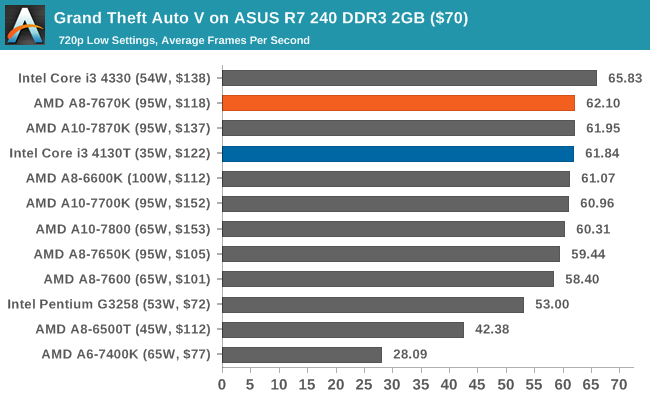
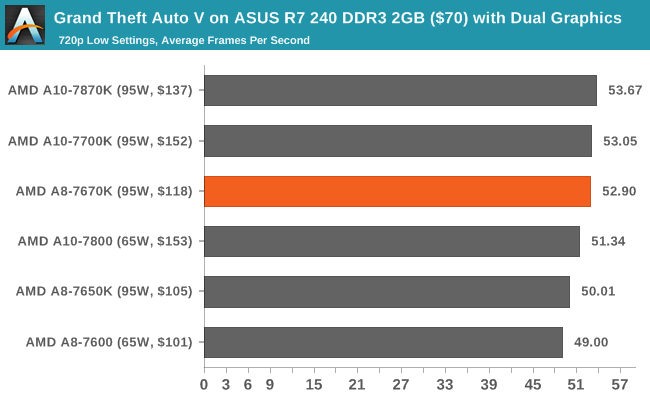
GRID: Autosport
No graphics test is complete without some input from Codemasters and the Ego engine, which means for this round of testing, we point toward GRID: Autosport, the next iteration in the GRID and racing genre. As with our previous racing testing, each update to the engine aims to add in effects, reflections, detail and realism, with Codemasters making "authenticity" a main focal point for this version.
GRID’s benchmark mode is very flexible, and as a result, we created a test race using a shortened version of the Red Bull Ring with 12 cars doing two laps. The player car is in focus throughout this benchmark and starts last, but usually finishes second or third. For low-end graphics, we test at 1080p and medium settings, whereas mid- and high-end graphics get the full 1080p maximum. Both the average and the minimum frame rates are recorded.
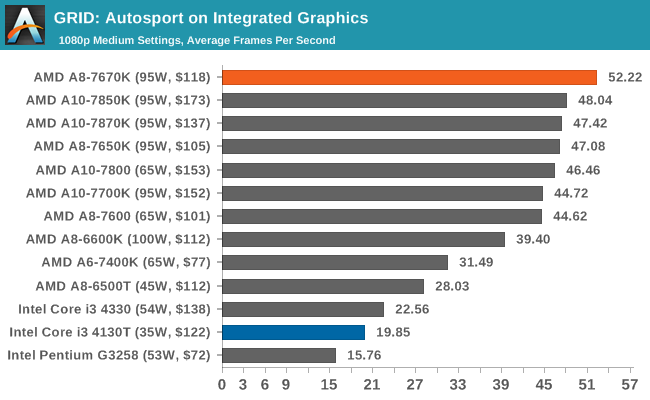
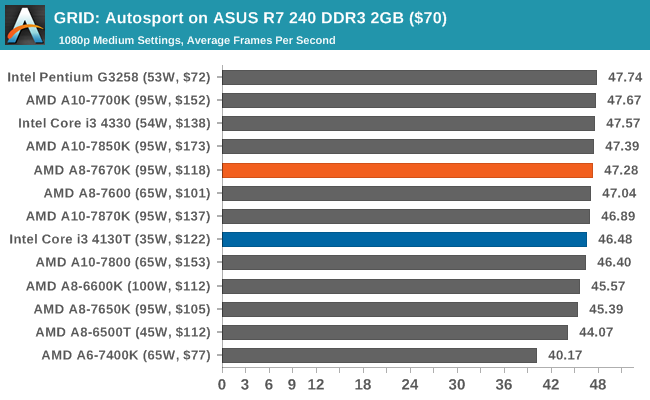
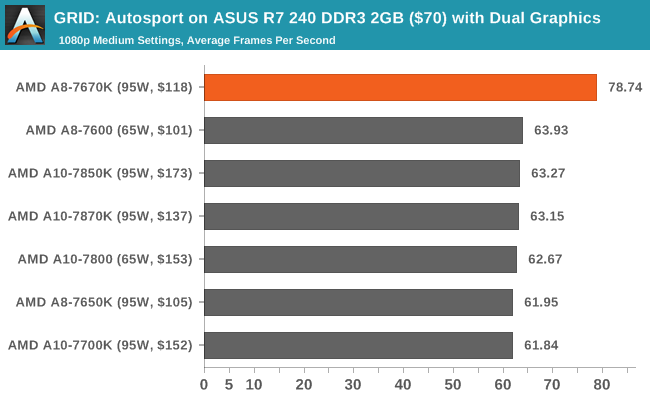
For whatever reason, the A8-7670K gets a good showing in the integrated tests, especially in dual graphics mode, with an abnormally high score. Some other issue might be at play here and warrants further testing.
Middle-Earth: Shadows of Mordor
The final title in our testing is another battle of system performance with the open-world action-adventure title Shadow of Mordor. Produced by Monolith using the LithTech Jupiter EX engine and numerous detail add-ons, SoM goes for detail and complexity to a large extent, despite having to be cut down from the original plans. The main story was written by the same writer as Red Dead Redemption, and it received Zero Punctuation’s Game of The Year in 2014.
For testing purposes, SoM gives a dynamic screen resolution setting, allowing us to render at high resolutions that are then scaled down to the monitor. As a result, we get several tests using the in-game benchmark. For low-end graphics, we examine at 720p with low settings, whereas mid- and high-end graphics get 1080p Ultra. The top graphics test is also redone at 3840x2160, also with Ultra settings, and we also test two cards at 4K where possible.
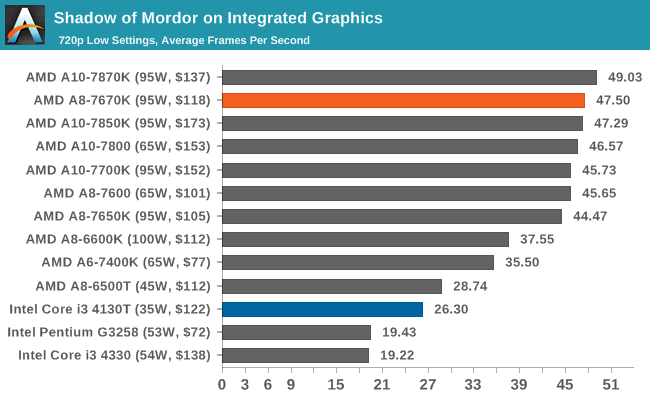
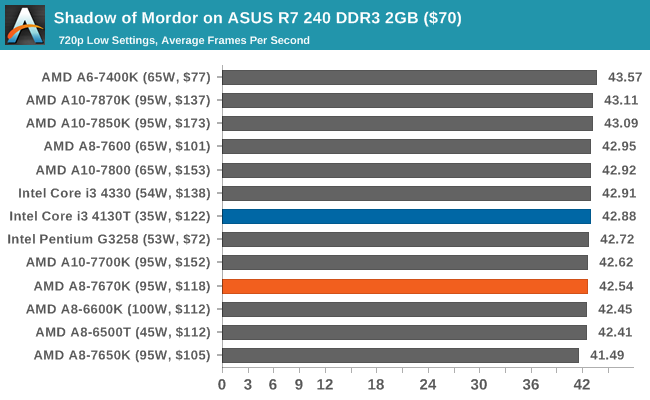
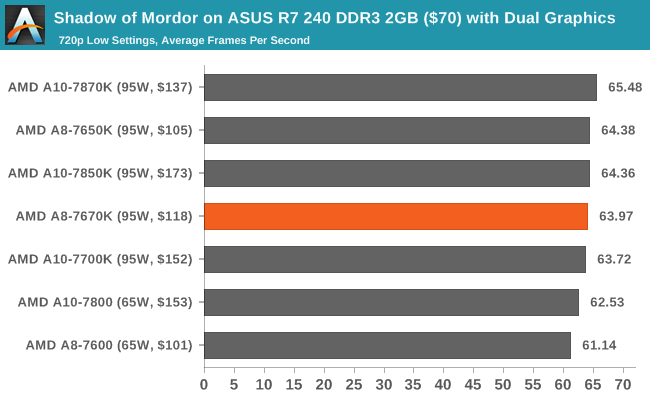















154 Comments
View All Comments
BrokenCrayons - Thursday, November 19, 2015 - link
I'd love to see better IGPs from Intel as well, but it really only serves to move the bottom rung of the graphics ladder up a notch. They don't seem like they'll ever really catch up with system requirements on contemporary games. It's more of a matter of waiting for the current Intel graphics processor to be good enough to run what's already been on the market for a while in terms of entertainment. Beyond that, if Intel dedicates more space to graphics, there'll invariably be someone else who complains that it's a complete waste for there to even be integrated graphics in the first place since they have a discrete GPU.raikoh05 - Thursday, November 19, 2015 - link
you can probably make it run better https://www.youtube.com/watch?v=uiCCKurW9TUplonk420 - Thursday, November 19, 2015 - link
how the hell is this doing better than an A10 with 128 more streaming processors?JoeMonco - Friday, November 20, 2015 - link
It's summed up as "LOL AMD".Rexolaboy - Thursday, December 10, 2015 - link
The a10 benchmarks are from the launch tests. Not current, there is no reason to include them. Anandtech fail.Tunrip - Friday, November 20, 2015 - link
"I outfitted my 15-year-old cousin-in-law with an APU" THE FUTURE IS HERE! :Dhmmmmmmmmmm - Friday, November 20, 2015 - link
People spending so much time on what-ifs. Why don't they just wait for the benchmarks for Zen and Kaby Lake instead of giving each other lessons in history and mathematics.BMNify - Saturday, November 21, 2015 - link
There is an incredible bias, but to no fault of your own, in the web benchmarks part. Considering that Intel is tied for second (with Opera. Samsung is the largest, of all companies) as the most active contributor for Chromium since about 2012, major effort is being invested by Intel to optimize Chrome for their chips. It just doesn't make logical sense every Intel chip performs that much better than AMD on web benchmarks other than they have invested a lot of time in helping advance chromium development. I mean come on, even a low end Pentium at stock speeds destroys even the highest AMD chip on those javascript/Web benchmarks. That has to be obvious bias.http://mo.github.io/assets/git-source-metrics-chro...
I am not knocking Intel as their efforts are commendable in chromium development and any Chrome users who also use heavy JS browser apps would be amiss to choose AMD, but just wanted to point out that in benchmarking (which should be as level field as possible), you guys should switch to another browser like Firefox or even IE 11/Edge.
hojnikb - Saturday, November 21, 2015 - link
Edge uses the same engine as Chrome... IE11 is old.If AMD actually invested something in software optimization wouldn't hurt.
Gigaplex - Monday, November 23, 2015 - link
Edge does not use the same engine as Chrome. Edge uses EdgeHTML and Chakra, Chrome uses Blink/WebKit and V8.